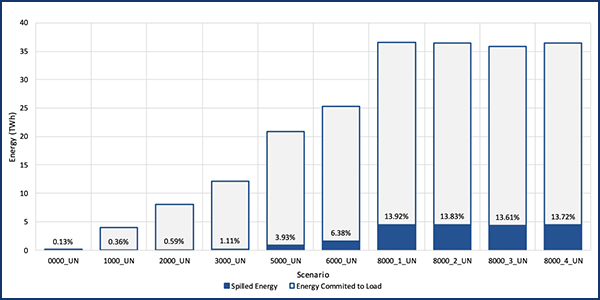New England’s grid will see diminishing returns from the incremental addition of offshore wind as more megawatts are added, with as much as 13.9% spilled annually, analysis from ISO-NE shows.
The yearly production pattern does not follow the pattern of load, causing spillage to be highest during low-load months and lowest during high-load months, according to Richard Kornitsky, ISO-NE assistant engineer for system planning.
Kornitsky was presenting a follow-up to questions from last month’s meeting related to the economic study conducted for the New England States Committee on Electricity. The organization, Anbaric and RENEW Northeast last year each requested separate studies from ISO-NE. (See “Modeling More Offshore Wind, Slowly,” ISO-NE Planning Advisory Committee: March 18, 2020.)
Kornitsky’s presentation focused on spillage stemming from oversupply, building on analyses performed for the NESCOE study for the year 2030.
Theodore Paradise, Anbaric senior vice president for transmission strategy, asked about the assumptions around the dispatch of the non-wind resources.
“Have we taken off all the oil units and any remaining coal, which is barely any, and all the natural gas we can, save for the stuff that needs to ramp and load follow? Or are we keeping a fair bit of that on, causing more spillage than you might have if it was off?”
“It more depends on how the wind is behaving at that specific hour, since in some hours, even in months such as April or May, you’ll have moments when you’ll have quite a bit of offshore wind,” Kornitsky said. “So, there might be hours where offshore wind is the main generation that’s serving load and you won’t have much of that conventional natural gas generation online.”
But Kornitsky also pointed to situations where the system will have very little or no offshore wind, at which point natural gas will be coming back online — and points in between.
“The main thing, especially when you get up to 8,000-MW cases, is there wind available, and that really dictates what other generation is online,” Kornitsky said.
The RTO’s next steps are to complete the ancillary services component of the NESCOE study for presentation in May and to publish the final report by June 1. The final Anbaric study will be published by June or July.
RENEW Study Shows Minimal Spillage
Kornitsky also presented the preliminary RENEW study results for 2025, reminding participants the study does not focus on offshore wind additions “but rather the impacts of the conceptual increases in hourly operating limits of the Orrington-South interface from conceptual transmission upgrades.”
The study has two scenarios based on estimated 2016 limits, which were modified to approximate the addition last year of a voltage regulating system at the Cooper Mills substation in Windsor, Maine.
Scenario 1 shows the same limits as the base case but has a transmission device at the Orrington-South interface with the equivalent impact of a large synchronous generator dispatched nearby, meaning all monthly limits are equal to or higher than the base scenario.
Scenario 2 also shows similar limits to the base case but includes a new 345-kV transmission path from the Orrington substation to the Maine Yankee station, with monthly limits higher than base or Scenario 1.
“We use threshold prices to decrease production of $0/MWh resources during oversupply and use of different threshold prices than indicated will produce different outcomes, particularly spillage by resource,” Kornitsky said.
“Under our base assumptions, we see New Brunswick imports, Hydro-Quebec imports, native New England hydro and utility PV would be all curtailed before curtailing NECEC [New England Clean Energy Connect], and finally, behind-the-meter PV would be curtailed last,” he said.
NECEC is a $950 million project to deliver 1,200 MW of Canadian hydropower to the New England grid in Lewiston, Maine, along a 145-mile transmission line controlled by Avangrid subsidiary Central Maine Power.
A set of NECEC sensitivity scenarios were performed assuming a higher threshold price of $11/MWh, which results in the curtailment of the line before other resources.
However, raising the NECEC threshold price from $2/MWh to $11/MWh does not greatly change the amount of total spilled energy systemwide.
Among the key observations: Systemwide production costs and load-serving entity energy expenses are similar among all the scenarios, and varying price separation is seen in LMPs at Bangor Hydro because of congestion at the Orrington-South interface.
Also, the base case provides the most congestion at the Orrington-South interface, while Scenario 2 provides the least congestion. Spillage is minimal across all scenarios.
“The scale of what’s being changed in this study is very different and smaller than the scale of what was being changed in the other two studies here, so there won’t be much impact on the total system,” Boreas Renewables President Abigail Krich said. “We’re looking at a very small pocket of the system, so in terms of looking at the results, I would hesitate to describe them as not significant on a system scale and more look at the impacts it has on the local area being studied.”
The RTO will publish the final RENEW report by July.
National Grid Study Request
National Grid lead analyst Kai Van Horn presented a new economic study request that would aim to build on earlier studies, modeling year 2035 to provide insight on wholesale energy market impacts, unit economics, utilization of resources, and the role of transmission and battery storage on a system with a high proportion of variable resources.
“The significant decarbonization targets are being set at the state level, which have major ramifications for the energy system,” Van Horn said. “Meeting those targets is going to require a lot of changes, and there are a lot of ways to get there. The broader set of solutions that we can consider, the better outcome we can get to in terms of meeting those targets.”
The proposed study focuses on two pathways: the efficient use of clean energy resources, and leveraging transmission and storage in order to do so, Van Horn said.





